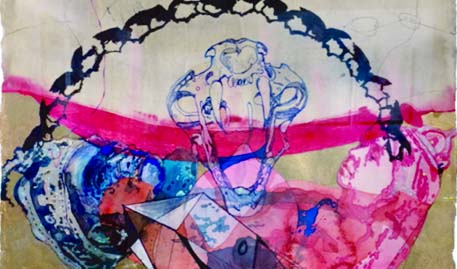
Contd from page 4 :
In (fig 7), Firoz depicts a female figure within finitely long hair which is strangling a white man like a venomous serpent, demonstrating the potential of the threat Indian women posed to British imperial power. This image contrasts with the depiction of women in colonial India by English landscape artist William Danielle.
In Hindu Female (fig 6), the woman is portrayed from behind carrying three pots of water on her head. The woman looks seductive. Her body is curvaceous, and her taut breasts and buttocks are exposed. In TheIndian Fruit Selle, the woman appears docile and fragile with her downcast gaze, but her breasts have been emphasized. Such asensuous exhibition of Indian women adheres to the representation of eastern female in colonial discourse, as a figure who is eroticized for the pleasure of white men, as stated by historian Rachel Ama Assa Engmann “the colonies were marketedby colonial elites as a place where colonizingmen could indulgetheir sexual fantasies.”
In Firoz’s work, the woman’s mass ofwavy hair predominates the scene, making her body appear inconspicuous in order to repel British colonial male’s voyeurism.
Firoz Mahmud’s Reverberation seems to challenge Western texts’ creation of stereotypical images of the east as irrational, backward, inferior, depraved and aberrant. Wherethe west was stereotyped in Western literature and art as rational, superior and virtuous. Firoz has used historical figures from the colonial British East India Company and the British Rajera and juxtaposed them against Nawabs and soldiers of India. The juxtaposition of west and east creates a visual equivalence demonstrated byposture, gesticulation and color. In some of the images the Indian soldier is portrayed authoritatively in relation to the colonizer, threateningthe image of western imperialism. Oriental women were represented as oppressed, submissive, voiceless and seductive, but Firoz has depicted a desexualized body of Indian women strangling the colonizer with her hair. Firoz Mahmud’s Reverberation echoes Edward Said’s groundbreaking text Orientalism, in which he criticized Western texts for constructing the stereotypical images of the Orient as exotic and inferior. Firoz’s work represents Said’s words in artistic form. n
(Selima Quader Chowdhury is Sr Lecturer at University
of Liberal Arts Bangladesh)
Bibliography
Journals
Ranjan, Priyanash. (2015) “Edward Said’s Orientalism: A Post-Colonial Culture Study” Journal of Humanities and Social Science, Vol 20 Issue 9, Ver II (Sept 2015), pp 85-88.
Liddle, Joanna and Rama Joshi. (1985) “Gender and Imperialism in British India” Economic and Political Weekly, Vol 20, No 43 (Oct 26, 1985), pp. WS72-WS78
Engmann, Rachel AmaAssa. ”Under Imperial Eyes.Black Bodies, Buttocks, and Breasts: British Colonial Photography and Asante Fetish Girls” African Arts, Vol 45 No 2 (Summer 2012), pp 46-57
In (fig 7), Firoz depicts a female figure within finitely long hair which is strangling a white man like a venomous serpent, demonstrating the potential of the threat Indian women posed to British imperial power. This image contrasts with the depiction of women in colonial India by English landscape artist William Danielle.
In Hindu Female (fig 6), the woman is portrayed from behind carrying three pots of water on her head. The woman looks seductive. Her body is curvaceous, and her taut breasts and buttocks are exposed. In TheIndian Fruit Selle, the woman appears docile and fragile with her downcast gaze, but her breasts have been emphasized. Such asensuous exhibition of Indian women adheres to the representation of eastern female in colonial discourse, as a figure who is eroticized for the pleasure of white men, as stated by historian Rachel Ama Assa Engmann “the colonies were marketedby colonial elites as a place where colonizingmen could indulgetheir sexual fantasies.”
In Firoz’s work, the woman’s mass ofwavy hair predominates the scene, making her body appear inconspicuous in order to repel British colonial male’s voyeurism.
Firoz Mahmud’s Reverberation seems to challenge Western texts’ creation of stereotypical images of the east as irrational, backward, inferior, depraved and aberrant. Wherethe west was stereotyped in Western literature and art as rational, superior and virtuous. Firoz has used historical figures from the colonial British East India Company and the British Rajera and juxtaposed them against Nawabs and soldiers of India. The juxtaposition of west and east creates a visual equivalence demonstrated byposture, gesticulation and color. In some of the images the Indian soldier is portrayed authoritatively in relation to the colonizer, threateningthe image of western imperialism. Oriental women were represented as oppressed, submissive, voiceless and seductive, but Firoz has depicted a desexualized body of Indian women strangling the colonizer with her hair. Firoz Mahmud’s Reverberation echoes Edward Said’s groundbreaking text Orientalism, in which he criticized Western texts for constructing the stereotypical images of the Orient as exotic and inferior. Firoz’s work represents Said’s words in artistic form. n
(Selima Quader Chowdhury is Sr Lecturer at University
of Liberal Arts Bangladesh)
Bibliography
Journals
Ranjan, Priyanash. (2015) “Edward Said’s Orientalism: A Post-Colonial Culture Study” Journal of Humanities and Social Science, Vol 20 Issue 9, Ver II (Sept 2015), pp 85-88.
Liddle, Joanna and Rama Joshi. (1985) “Gender and Imperialism in British India” Economic and Political Weekly, Vol 20, No 43 (Oct 26, 1985), pp. WS72-WS78
Engmann, Rachel AmaAssa. ”Under Imperial Eyes.Black Bodies, Buttocks, and Breasts: British Colonial Photography and Asante Fetish Girls” African Arts, Vol 45 No 2 (Summer 2012), pp 46-57

